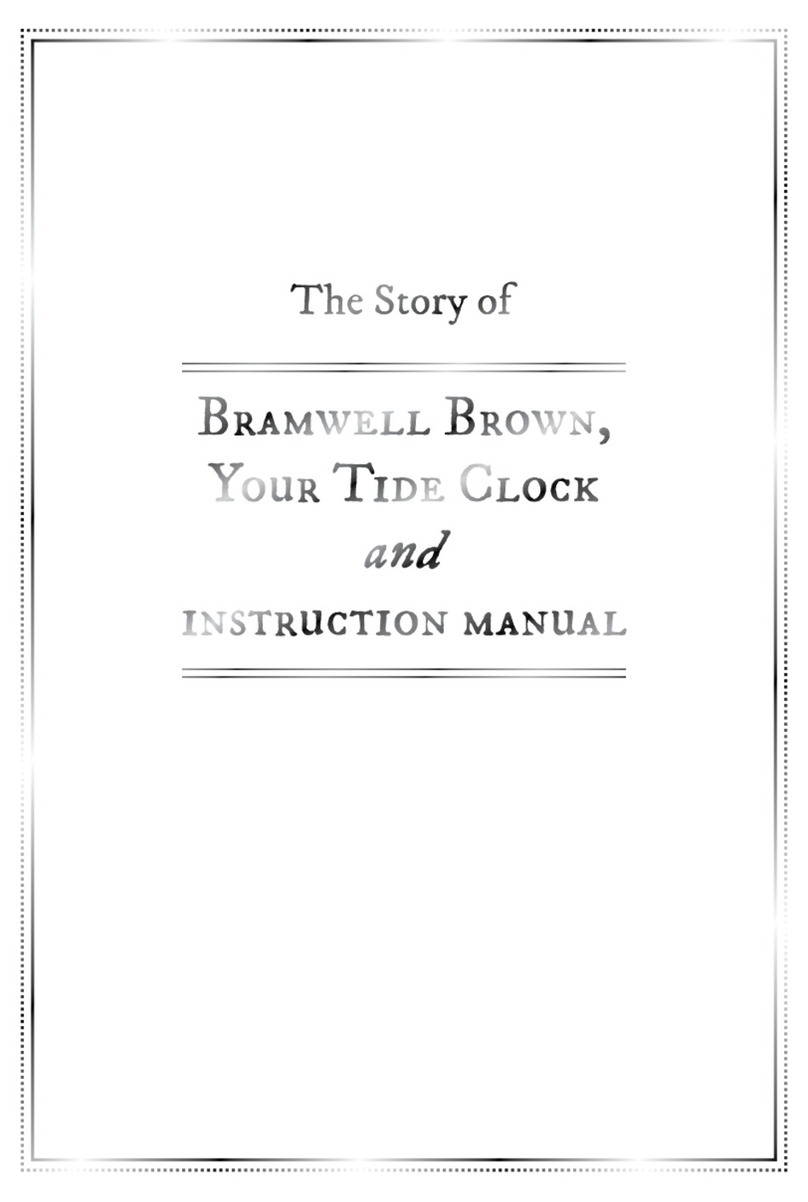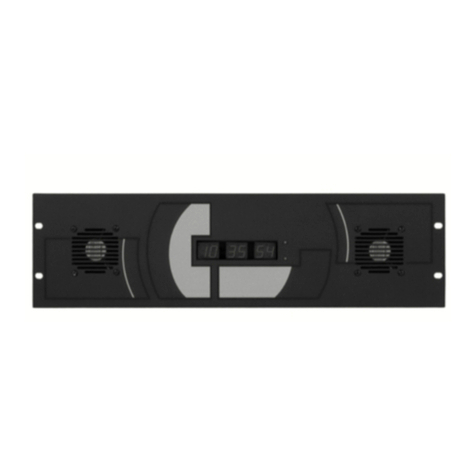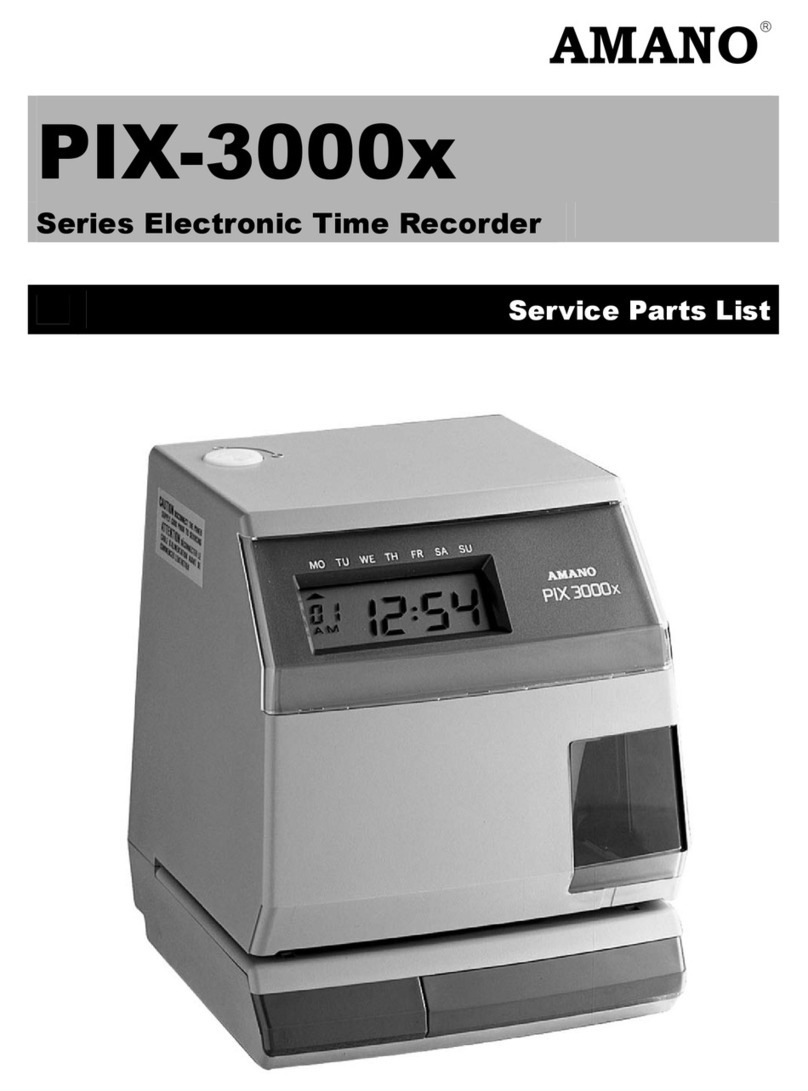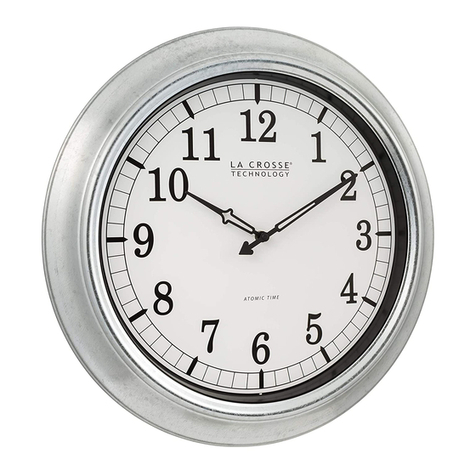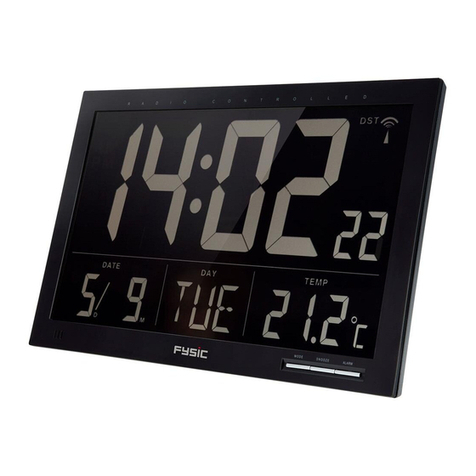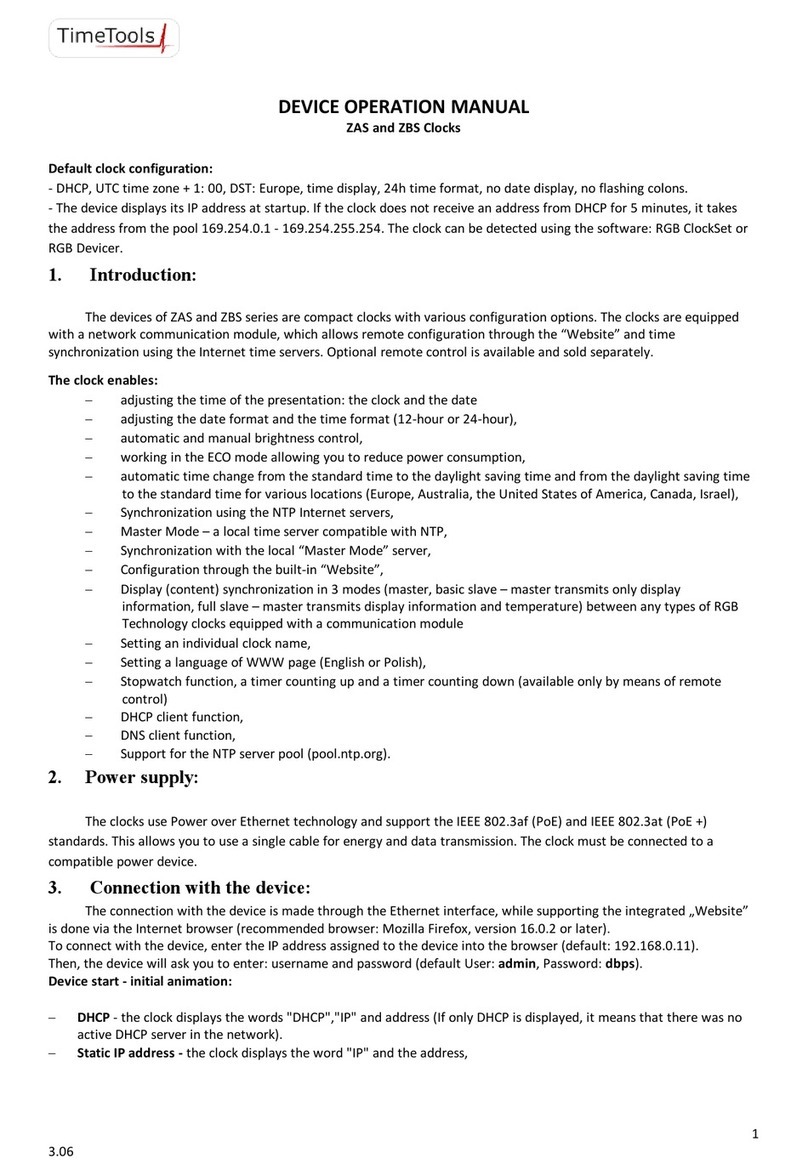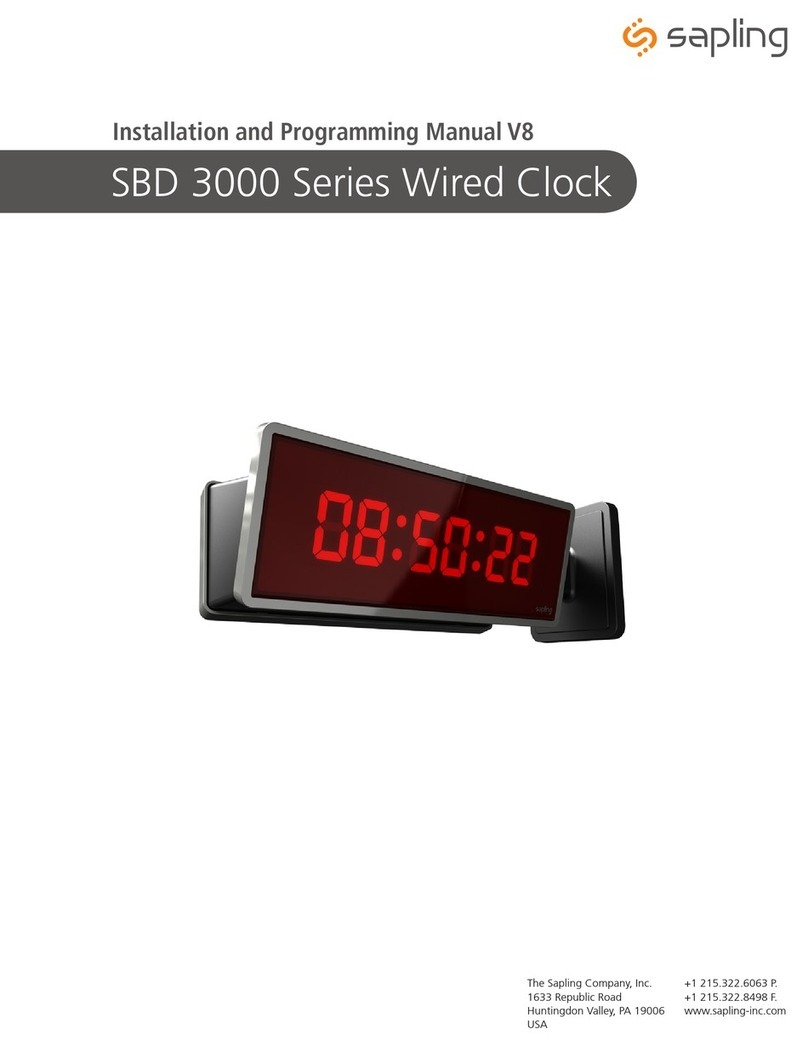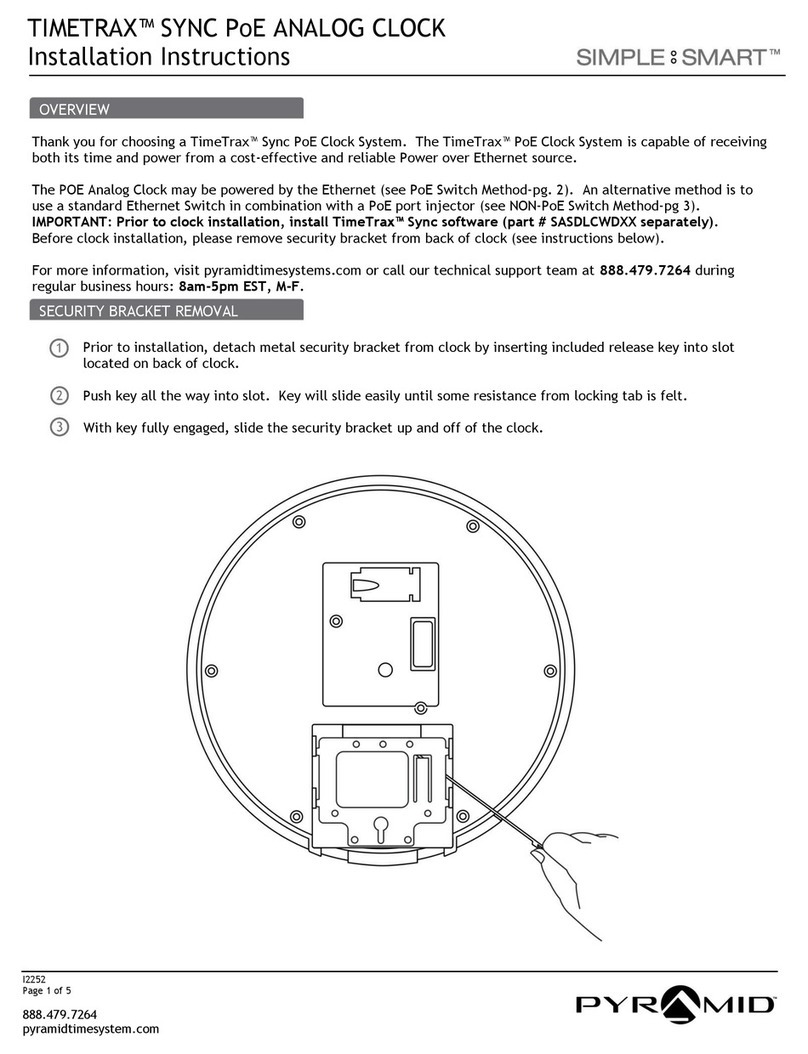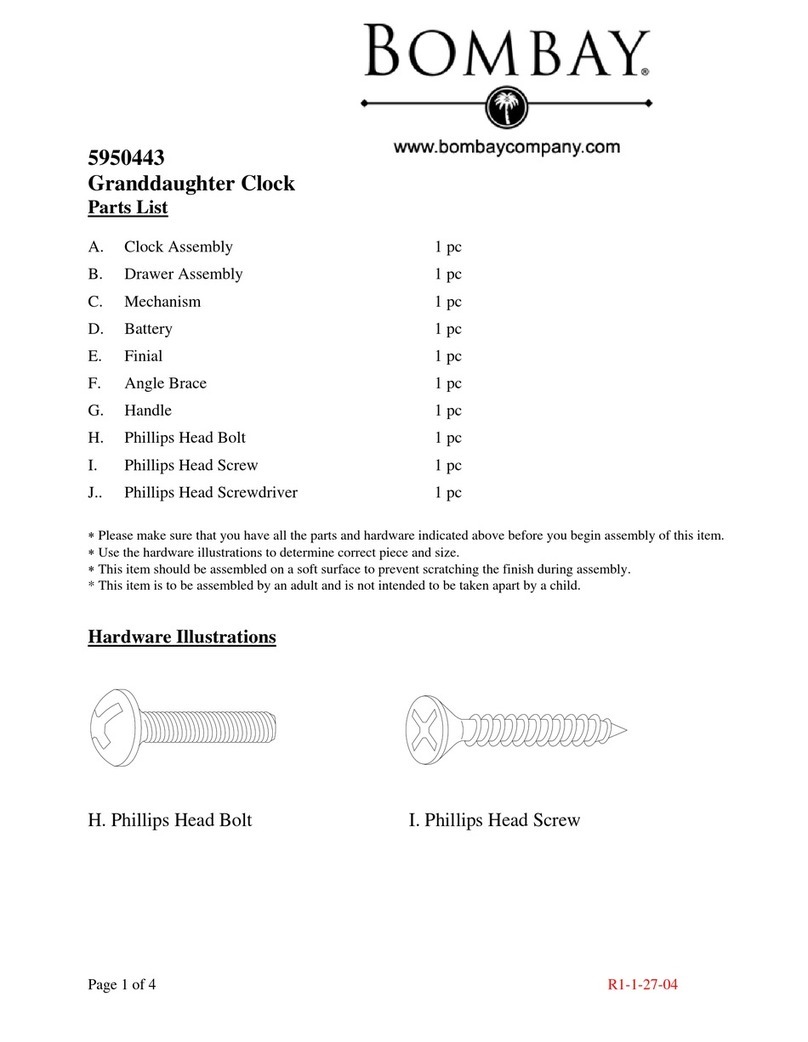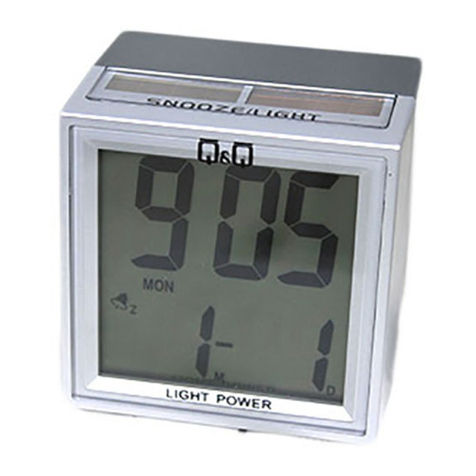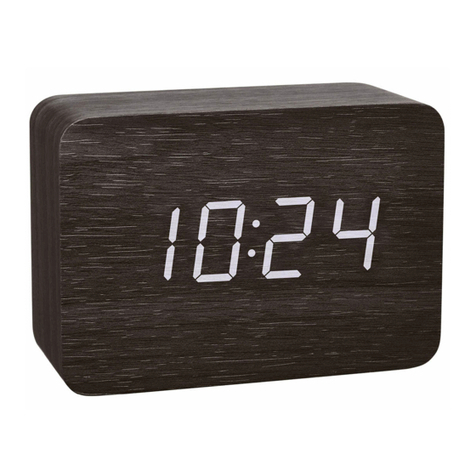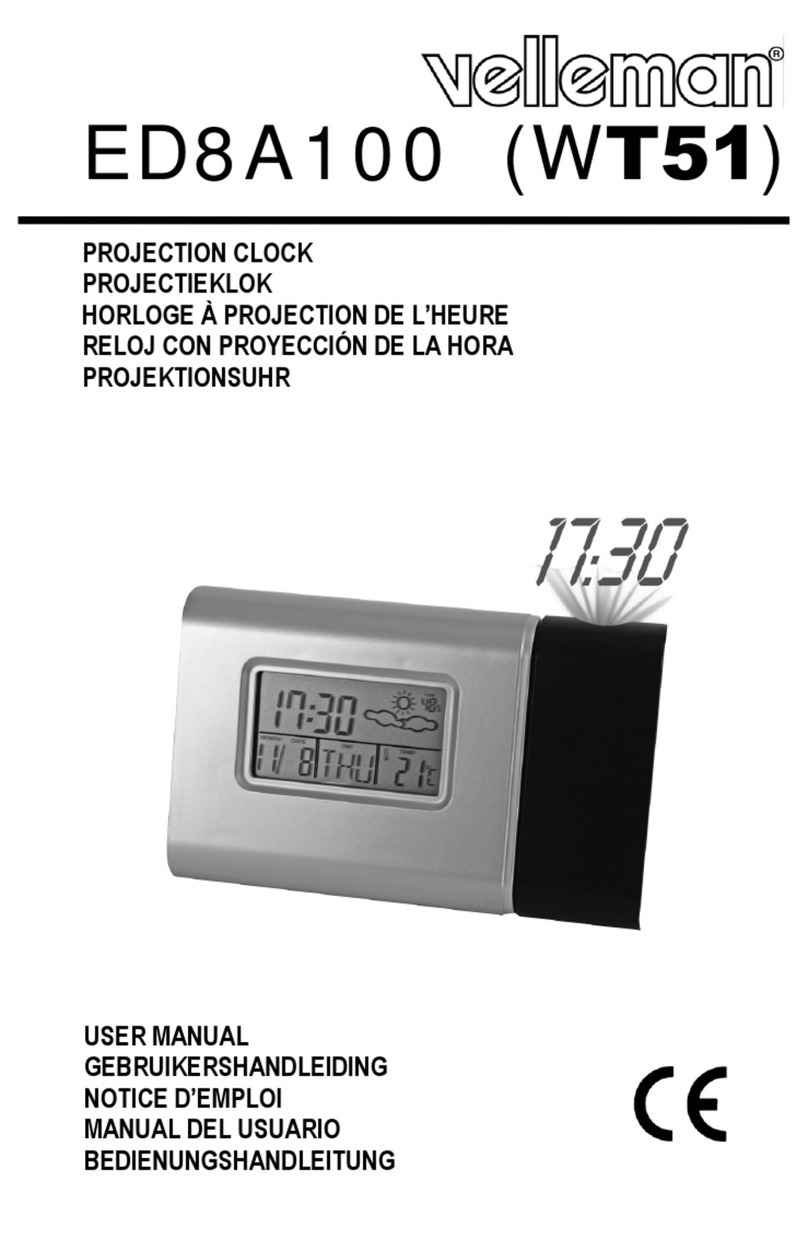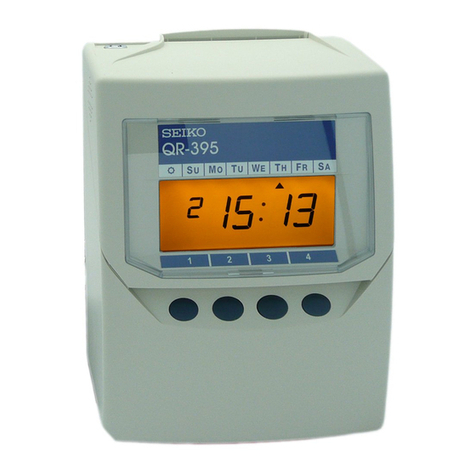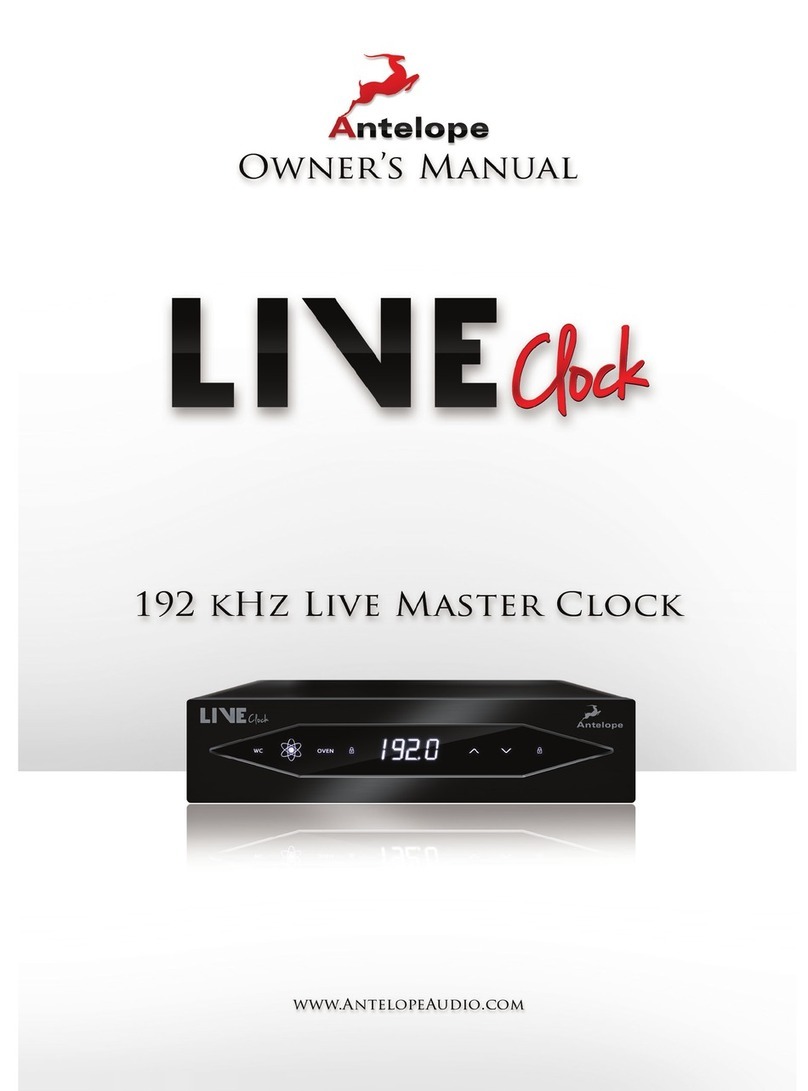Bramwell Brown Barometric Weather Clock Assembly instructions

An instruction Manual
and Guide to your
Barometric
Weather Clock


Hello there!
We would dearly like to thank you for purchasing your
barometric Weather Clock. However dark and moody
the weather may get, we hope your own mood is always
brightened by the charming animated artwork.
We’ve provided this booklet not just as an instruction
manual but to tell you a little of our story to date and the
ethos of our budding business.
To maximise your enjoyment of the clock’s forecasts we
thoroughly recommend reading our explanation as to how
this function of the clock works. You’ll also nd user tips and
details of how to register your clock’s serial number on our
website to extend its warranty.
We hope your clock will be enjoyed by all those who interact
with it for many years to come!
All the best,
(Brother & Sister, Founders of Bramwell Brown)
1

Contents
Extend your warranty page 3
Taking care of your clock page 3
Setting and using your Weather Clock page 4
Hanging the clock page 6
How the clock works page 8
What is a Barometer? page 9
Forecasting the weather with a Barometer page 10
What the clock should not be used for page 11
Changing the batteries & recycling advice page 12
About Bramwell Brown Clocks page 13
Problem Solving, FAQs and clock servicing page 14
2

Extend Your Warranty
First things rst, all Bramwell Brown clocks come with an
automatic one year warranty, provided you retain proof of
purchase. We also offer the opportunity to extend this to
two years by registering the number on the back of your
clock with us.
To register go to: www.bramwellbrown.com and follow the
links in the ‘Contact Us’ Section.
Taking Care of Your Clock
We have taken every care to ensure your clock is of the
highest build quality so it can be enjoyed for many years
to come. However, being a complex mechanism, there is a
certain degree of fragility that will obviously not withstand
extreme forces or temperatures. As with any mechanical
instrument, please bear this in mind when handling it and
when choosing where to position it in your home. For
example, we strongly advise against hanging it directly
above a radiator or next to a South facing window. Please
also note that your clock is for indoor use only!
The layers of mechanical weather scenery in your clock have
been carefully optimised to work with the clock in an upright
position, as hung on a wall. Therefore, to avoid putting
unnecessary strain on the mechanism, do not allow the clock
to move mechanically when laid horizontal. This is important
to remember when rst switching the clock on.
If storage is required, please store in an upright position
and switched off to avoid risk of damage to the clock’s
mechanics. We also recommend removing the batteries if it
is not going to be used for some time.
3

Setting and Using Your Weather Clock
Setting the Time:
To activate the clock mechanism (which runs independently
to the barometer and weather scenery), locate the AA
battery included with your clock and insert it into the central
quartz clock movement on the back.
Adjust the time by rotating the green knob found next to
where you inserted the battery.
Activating the Mechanimated Weather:
Now for the exciting part!
1) Your clock’s ‘transport lock’ (which protects it from
damage during transport) will be clearly labelled on
the back of the clock. This must be removed before the
batteries are inserted.
2) To remove the transport lock, simply unscrew in an
anti-clockwise direction and pull out when it becomes
loose. Please note, reinserting the transport lock should
never be attempted as to do so can damage the
mechanism.
4

3) Ensure the red on-off switch on the back is in its “O” (off)
position.
4) Unscrew and open both battery covers. (Peel off the
temporary transport lock warning label to gain access if
it is still in position.)
5) Install the 8 D-Cell batteries provided, ensuring all are
correctly orientated and making good contact. Replace
the covers. It’s worth taking care here as the batteries
can spring up and out of position.
6) Turn the switch to ‘on’ only when the clock is in an
upright position. (Remember to turn the clock off again
any time the clock is to be laid at.)
7) The Mechanimated weather scenery will then
immediately move to one of the ve weather scenes.
The clock can now be hung on the wall.
Please note, the weather scenes shown during the rst
24 hours of movement may not represent an appropriate
forecast as the clocks needs a little while to track the
changing air pressure before forecasting more accurately.
There are no manual adjustments required to the mechanics
once the clock is up and running and there is no way of or
need to calibrate the barometer.
5

Demonstration Mode:
You can activate the ‘weather artwork demonstration’
function any time by pressing and momentarily holding the
button on the bottom of the clock.
This makes the clock wizz around so you can show it off to
friends and family. The button can be a little stiff but press it
rmly until you hear a click, ideally while steadying the clock
on the wall with your other hand.
Hanging the Clock
Depending on the size of your clock, it will have either one
or two screw holes on which to hang it on the wall. Included
as part of the clock’s packaging is a clock hanging template
which provides further instructions and allows you to easily
locate exactly where to drill and position the screw(s). You’ll
need two screws for a large clock and just one for a regular
clock. We don’t include these or recommend any specic
type as this will depend on the nature of your wall.
Start by working out where and at what height you want to
hang your clock then position the drilling guide to match
the desired clock outline. (If you have some masking tape
to hold the guide to the wall this would make things easier!)
For large clocks do also take care to ensure the horizontal
line on the drill guide is level!
You can then mark the wall through the card (perhaps with
6

the tip of a nail) and remove the template prior to drilling on
the newly marked locations.
Please take care to ensure you use a drill bit, wall plugs
and screws that are appropriate to your wall type as well
as taking appropriate safety precautions when using a drill.
This includes ensuring the section of wall is suitable to drill
into, for example, free of electrical wires. Take advice if
necessary or ask a professional for help!
7

How the Clock Works
The clock has a barometric air pressure sensor at its core
that continually measures the atmospheric air pressure
throughout the day.
Even inside a relatively air-tight home, the air pressure
changes are sufcient for your clock to forecast from, as you
will see.
By monitoring the air pressure, the clock can tell whether it
is rising or falling in relative terms over time – an important
aspect of weather forecasting. (See the following sections
for further details.)
Very simply, if the clock notices the air pressure is rising then
it will forecast sunnier weather. Conversely, if air pressure
falls then the clock will forecast rain. The faster the rate of
change, the more extreme the swing in either direction.
With just these simple parameters to work from, one has to
expect the barometric forecast to not always mirror the sky
outside. The clock’s illustration of what the air pressure is
doing may sometimes surprise you, however, we hope you
will nd its more whimsical tendencies amusing and a true
reection of the simplicity of barometers of old. There is
more information to follow and a much more in depth guide
available on our website.
8

What is a Barometer?
The story starts in the 16th Century when Italian clever-man
Evangelista Torricelli is thought to have been the rst person
to recognise that the world’s atmosphere was not weightless
but applied a force, now known as atmospheric pressure.
Only in the 18th Century was the link between atmospheric
pressure and changing weather conditions noted.
Water-lled “storm glass” barometers did what their name
suggests and predicted impending storms.
The 19th century saw the development of the aneroid
barometer which became widely used for meteorology and
a popular accessory in the home. These aneroid barometers
were produced in all manner of ornate designs in response
to the insatiable British appetite for a topic of conversation,
the use of umbrellas and organising picnics.
With the advent of improved satellite weather forecasting,
barometers became more regarded as an instrument
for an older generation with their natural interactions
overshadowed in an ever digitalised world. Your new
Weather Clock is a reaction against this and a celebration of
the intricate mechanics of bygone eras brought up to date
for the contemporary home.
9

10
Forecasting the Weather with a
Barometer
The traditional barometers of old required a certain degree
of familiarity and regular observation to be used accurately.
This is because it is not the absolute value of the air
pressure at any given moment that matters, but the amount
and direction in which it changes.
Your own Weather Clock contains a nifty electrical
barometer that calculates the rate of change in atmospheric
pressure. It therefore does more than a traditional
barometer, monitoring the changes and their rapidity for
you – translating these into forecasts. This means that what
you see in the mechanically animated sky should, more
often than not, be what you get when you step outside in
the following few hours.
Large, swift changes in pressure usually lead to signicant
changes in the weather. Fast drops in atmospheric pressure
often result in unsettled weather and rapid rises are
associated with improving conditions and clearing skies.
Whilst there is nothing else at all that affects the clock’s
weather scenery movements apart from changing air
pressure, other variables such as temperature and humidity
do also have an important part to play in modern weather
forecasting. Barometers (and air pressure), therefore, have
always been more often used as a simple and convenient
guide to changing conditions. For example, the air pressure
in the clock’s location could drop, leading it to change
its display to ‘Rain’. The rain may not, though, arrive at
that moment or in the subsequent hours or days if other
meteorological factors are at play such as temperature and

11
humidity. Whilst this may seem rudimentary, at Bramwell
Brown we hope it also adds a level of charm to the clock!
As well as this, taking its design from traditional barometers,
your clock only has ve weather scenes to categorise all the
possible weather conditions. These being: ‘Stormy’, ‘Rain’,
‘Change’, ‘Fair’ and ‘Very Dry’. It is not unusual, therefore,
for the clock to change relatively infrequently during periods
of steady pressure. As well as this, it is worth noting that the
barometric forecast for ‘Very Dry’ is reached rarely as this
requires periods of especially high – and further rising – air
pressure. The adjacent forecast for ‘Fair’ most often covers
periods of good (even glorious!) weather conditions and it is
normal for this display to show a small amount of uffy white
cloud.
What the Clock should not be used for:
Our top 3 “No no’s”
1. Do not rely on the clocks as a replacement for
publically available meteorological weather forecasting
in situations where you or others depend on such
information for personal safety or security. Please
remember that the weather clock is primarily for visual
enjoyment rather than a serious guide to changing
weather.
2. If you are lucky enough to have one, do not use the
clock in your home sauna. Similarly, do not position the
clock directly above a hot radiator as this will damage
the delicate internal mechanism.
3. Like a Queen’s guard on parade outside Buckingham
Palace, the clock must not lie on its back whilst on duty.

12
Its mechanism may be damaged if it is switched on and
the animated artwork moves whilst it is not in an upright
position.
Changing the Batteries & Recycling
Advice
The batteries included with your Weather Clock will, of
course, not last forever. When the remaining battery life
reaches a lower level a clever mechanism switches off the
demonstration function to conserve power. This helps
maximise the amount of time your clock will continue its day
to day function – which in normal circumstances should be
over a year. Other signs that the battery power has reached
an insufficient level can be quite strange and include the
mechanism juddering, sticking or becoming lazy. See the
‘Problem Solving and FAQs’ section further on for more
details.
When the batteries need replacing you can choose to
either replace all 8 or just 4, with either the left or right hand
battery chamber completely empty. The clock will run as
normal with just 4 batteries but the demonstration function
will not work and, clearly, the battery lifespan of 4 will not
match that of a complete set of 8.
When the batteries have expired please dispose of them
responsibly and recycle them where local facilities allow.
If you are in the UK you can nd out where your nearest
recycling service by entering your postcode at:
www.recycle-more.co.uk
Bramwell Brown has also gone to great lengths in making
sure that your clock has been designed in a way that

has minimal environmental impact. Central to this is the
ability to have any of the clocks in the Bramwell Brown
range serviced, repaired and updated like you would with
any other family clock or valuable timepiece. We hope,
therefore, that you would never consider simply ‘throwing
out’ your Weather Clock before either seeking repairs
undertaken by Bramwell Brown, another expert or perhaps
even yourself. If, for whatever reason, you think your clock
might need some attention, please see the ‘Contact Us’
page on the website for further advice and how to get in
touch.
About Bramwell Brown Clocks
Not only do we cater for the British obsession with the
weather, we are proud to design and build all of our
clocks in Great Britain. All our clocks are assembled by our
dedicated workshop team in Hampshire, where, for every
clock, over 100 parts are carefully pieced together by hand
before being hung on the wall for a thorough test. A short
video of this in action can be found on the website!
The Inspiration and Design behind Your Weather
Clock
Bramwell Brown was founded with the simple idea of using
imaginative design to reinvent classic time-pieces and
barometers for the 21st century.
We are a London-based brother and sister team from
the weather beaten West-Pennine Moors of the North of
England. Our inspiration came from the analogue displays
and mechanics of traditional time pieces that our Dad
tinkered with at home, plus a desire to create clocks that
13

were simply a bit more exciting!
It is our aim that through modern innovation we give our
time-pieces functionality to match any digital device. By
incorporating intriguing mechanics and inventive design
they are more visually engaging and bring a smile to your
face!
Our range of ‘Mechanimated’ clocks, is always developing.
To see the currently available range, do revisit our website,
follow us on social media or sign up to our mailing list.
Problem Solving, FAQs and Servicing
We, of course, hope you do not have any concerns over
the functioning of your clock, however, below you will see
a list of the most commonly seen issues and how to solve
them. There are also more in-depth answers to FAQs on our
website if you cannot nd the answer to your query here.
The forecast doesn’t seem to be accurate
If you haven’t already, we would recommend you read the
above sections on ‘How the Clock Works’ and ‘Forecasting
the Weather with a Barometer’. This will advise a little
further on how the clock relies entirely on atmospheric
air-pressure changes for forecasting and, subsequently, has
some idiosyncrasies. There is also a wealth of information,
explanation and trouble-shooting tips on our website. It is
worth noting that forecasts can become less accurate when
the clock is drained of battery power. If the clock’s forecasts
become erratic after a sustained period of good use, then it
may be worth considering swapping in new batteries for the
existing ones.
14

The weather scenery in my clock is juddering
It is natural to assume this signies that there is a problem
or a jam in the weather mechanism, however, fear not! This
is in fact a well-recognized sign that the motor is receiving
insufcient power from the batteries because either (a.) The
batteries are running low and need replacing or (b.) One or
more of the batteries have popped out of position and so
are not making good contact with the circuit. Try checking
the batteries are correctly installed or replace with new ones
and normal working order should be restored.
The scenery in my brand new clock is juddering
If this is the case, we’re very sorry. It sounds like your clock
has taken a bump in the post on its way to you. Please don’t
worry, we are here to help and really hope to be able to
get the clock working really swiftly. It may well be that the
clock just needs a manual reset which is quite simple to do
and we could possibly guide you through this. Please get in
touch via the ‘Contact Us’ page on the website and we’ll get
it sorted out for you as quickly as possible.
There’s a problem with the clock hands or
time-keeping
The fragility of the clocks means that the hands are quite
vulnerable to loosening during shipping. This can, on
occasion, mean that they slip slightly over a considerable
period of time and may affect their alignment or
time-keeping. Should you have any concerns of this nature,
there is a link on our ‘Contact Us’ page which is the best
place to get in touch to let us know. We can then advise
the best course of action to sort it out. This may include
organising a repair at our workshop or enabling you to
15

realign the hands yourself, should you wish to.
The weather scenery and text seems to be stuck
between scenes
This can normally be corrected by pressing the
demonstration button on the bottom of the clock. If this
doesn’t work, the cause is usually lack of power to the
motor that moves the weather scenery between its different
forecasts. The clock may seem to get ‘lazy’ and change
less frequently or not move far enough when the forecast
updates. A juddering effect may also be seen. Again, check
that none of the batteries have popped out of position
and/or try replacing with fresh batteries.
I can see a small dimple in the frame
Some small dimples on the surface of the metal clock frame
are unavoidable. This is where the essential mechanism
xing brackets are hand welded to the inside of the spun
steel frame. While we go to great lengths to keep them
minimally visible, it is usual to nd one or two on close
inspection. They reect the nature of this handmade
product.
I’ve dropped my clock and it’s broken (or it just
needs a service)
Our friendly workshop team will be happy to accept
your clock back and get it repaired for you. Please visit
the website and go to the ‘Contact Us’ page to let us
know what’s happened and we’ll be back in touch with
suggestions and/or a plan of action to help you out.
16


www.bramwellbrown.com
bramwellbrown
Bramwell Brown Clocks
#mybramwellbrown
This manual suits for next models
1
Table of contents
Other Bramwell Brown Clock manuals
